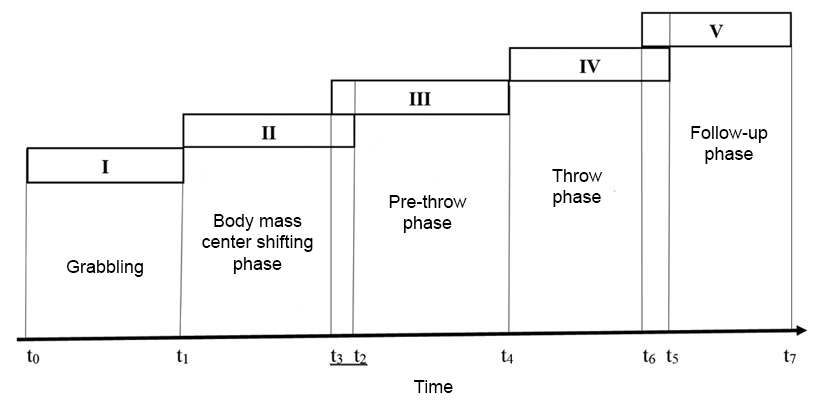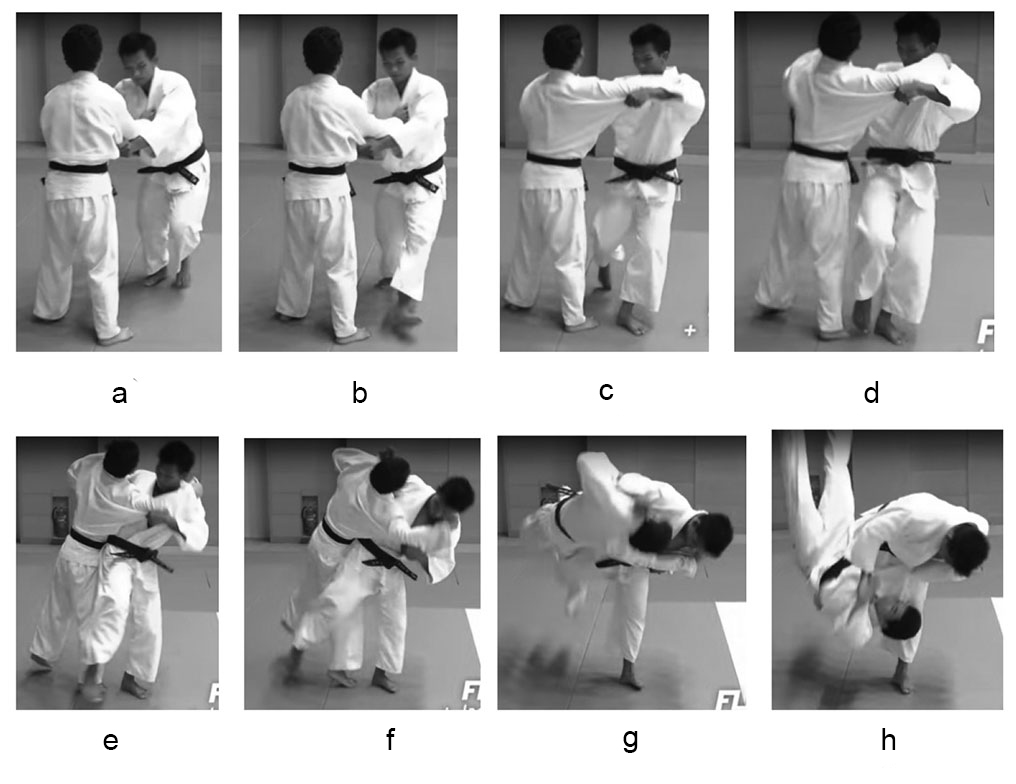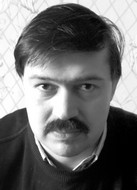Throw technique biomechanics in competitive wrestling
Фотографии:
ˑ:
PhD D.A. Matveev1
PhD, Associate Professor A.A. Potsipun1
PhD, Associate Professor O.V. Oshina1
Dr.Hab., Professor A.G. Levitsky2
1St. Petersburg State University, St. Petersburg
2P.F. Lesgaft National State University, St. Petersburg
Keywords: combat techniques, sambo, judo
Background. The study was performed at P.F. Lesgaft National State University and Saint Petersburg State University; with the modern combat sport techniques classified into the following four groups: coupled force; lever; block and combined groups [1]; with each group supported by the relevant elementary physics driven model, and a combined group applying the combined model. The classification was inspired by the ideas of A. Sakripanti [4], a judo sport analyst from Italy.
Objective of the study was to provide a theoretical basis for the throw technique biomechanics in the modern competitive combat sports.
Study findings and discussion. One of the purposes of the study was to analyze the body mass travel patterns in the competitive combat sport techniques [3]. Based on the study data, we developed a standing technique biomechanics scheme (see Figure 1) including the following five phases: grabbling phase; body mass center shifting (imbalance) phase; pre-throw phase; throw execution phase; and follow-up phase.
Phase I (grabbling move) is intended to secure a firm contact with an opponent. The phase may be modeled using a thread or a combination of rods. Given on Figure 1 is the phase timeframe, from the starting point t0 to the finishing point t1. It should be noted that the grabbling technique related issues are still largely underexplored today despite the fact that this throw stage is highly important and deserves being analyzed [3].

Figure 1. Throw technique biomechanics
Phase II (Body mass center shifting move) is widely referred to in the modern sport literature as the ‘imbalance stage’ starting right after the grabbling phase and including the following two steps. Step one is the time when the body mass center of the opponent is imbalanced by his bodily parts being shifted. Step two is geared to move the opponent’s body mass center to the best point for the throw. It should be mentioned that a throw may not always be grouped into both of the steps as sometimes only one step may be found. It is not unusual that the opponent’s position may be awkward enough to facilitate the throw without a special preparatory step one, albeit the practical experience shows that the imbalance stage may not be neglected since it is critical for success in every action. Given on Figure 1 is the phase timeframe, from the starting point t1 to the finishing point t2.
Phase III (pre-throw move) is designed to facilitate the throw execution as detailed by the relevant biomechanical model classifiable, as mentioned before, into coupled force; lever; block and combined groups. Phase III follows Phase II, with the phase timeframe, from the starting point t3 to the finishing point t3 given on Figure 1, albeit it should be mentioned that the timeframe is rather individual.
Phase IV (throw execution move) is describable by the relevant biomechanics model, with the fighter expected to clearly understand the model operation mechanism. This phase should follow the previous phase. When the movement phase is unprepared by the previous phases, it may be not successful enough. Given on Figure 1 is the phase timeframe, from the starting point t4 to the finishing point t5.
Phase V (follow-up move) is designed to control the opponent’s fall to the ground. This phase may start up before the prior phase is finished. Given on Figure 1 is the phase timeframe, from the starting point t6 to the finishing point t7. The phase execution is rather individual i.e. specific for each athlete.
Given on Figure 2 hereunder is the grabbling throw О-soto-gari classified into the following phases: (а) grabbling phase; (b) imbalance phase; (c) (d) second step in the second phase; (e) third phase; (f) (g) fourth phase; and (h) (i) follow-up phase.

Figure 2. Grabbling throw (О-soto-gari) scheme [5]
Conclusion. The proposed throw biomechanics scheme makes it possible to:
- Individualize throw techniques applied by every athlete;
- Better understand and improve existing techniques;
- Diversify every technique within the same model since phases II and III, IV and V overlap; with the energy costs of different throw versions often being close enough;
- Develop new technical actions for standing positions;
- Engage the 13-14+ year-olds into the training process to cultivate due understanding of the throw physics and biomechanics and, hence, facilitate their conscientious technical progress; and
- Step up motivations for the modern wrestling and martial arts in the technical university students.
References
- Levitskiy A.G., Matveyev D.A., Potsipun A.A. et al. Biomekhanicheskaya klassifikatsiya priemov sportivnoy borby [Biomechanical classification of actions in wrestling]. Teoriya i praktika fiz. kultury, 2017, no. 10, pp. 66-68.
- Vaganova N.V., Levitskiy A.G., Matveyev D.A. et al. Analiz izmeneniya raspolozheniya tsentra tyazhesti v sportivnoy borbe [Analysis of change in location of center of gravity in wrestling]. Mezhdunar. nauch. konf. po mekhanike ‘Vosmye polyakhovskie chteniya' [Proc. Intern. sci. conf. on mechanics '8th Polyakhov conference'], St. Petersburg, 2018, P. 280.
- Yugay K.V., Tabakov S.E. Statistika pokazateley realizuemosti vyponennykh zakhvatov sportsmenami razlichnykh vesovykh kategoriy chempionata mira po sambo 2015 goda [Statistics of indicators of realizability of holds by athletes from different weight categories in World Sambo Championship 2015]. Mater. XVI Mezhdunar. nauch.-prakt. Konf. pamyati zasluzhennogo mastera sporta SSSR, zasluzhennogo trenera SSSR, professora E.M. Chumakova [Proc. XVI Intern. res.-practical conf. in honour of USSR Merited Master of Sports, Honoured Coach of the USSR, Professor E.M. Chumakov]. Moscow, 2017, pp. 50-55
- Available at: http://www.academia.edu/2401906/A_Biomechanical_Reassessment_of_the_Scientific_Foundations_of_Jigoro_Kanos_Kodokan_Judo (Date of access: 10.02.2018)
- Available at: https://www.youtube.com/watch?v=1JL1Hw7M3cU (Date of access: 7.06.2018)
Corresponding author: khubbiev@gmail.com
Abstract
The study analyzes the throw technique biomechanics in the modern competitive combat sports based on the authors’ classification of throws into four groups including: coupled force; lever; block and combined groups, with each group supported by the relevant elementary physics driven model, and the combined group applying the combined model. The action scheme implies the following five phases: grabbling phase; body mass center shifting (imbalance) phase; pre-throw phase; throw execution phase; and the follow-up phase. The proposed scheme applies a movement algorithm with the relevant mechanical values to:
- Individualize throw techniques applied by every athlete;
- Better understand and improve existing techniques;
- Diversify every technique within the same model since phases II and III, IV and V overlap; with the energy costs of different throw versions often being close enough;
- Develop new technical actions for standing positions;
- Engage the 13-14+ year-olds into the training process to cultivate due understanding of the throw physics and biomechanics and, hence, facilitate their conscientious technical progress; and
- Step up motivations for the modern wrestling and martial arts in the technical university students.



